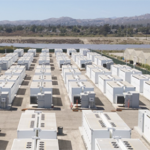“Instead of trying to adapt conventional energy technology to the special challenges of wave energy, we developed a technology that is adapted to the ocean from the start,” says Rafael Waters…
“This means that a wave energy station with an ordinary generator needs energy transmission systems such as gearboxes or hydraulic systems and other complicated details that wear out and require much more maintenance than a linear generator,” says Rafael Waters. “Our generator has functioned without any trouble every time we started it up over the years, even though it has received no maintenance and has sometimes stood still for months.” Rafael Waters and his colleagues are busy determining parameters such as power output and buoy size in order to attain the best results in the long term. “With smaller buoys and lower power output, there is less stress on the wave power station. On the other hand, the goal is to produce as much power as possible. This is ultimately an economic consideration, and we want to understand how to optimize the construction.”
For nearly three years, a wave power plant has stood on the bottom of the ocean a couple of kilometers off the west coast of Sweden, near Lysekil. Rafael Waters, from the Uppsala University Division of Electricity, designed and built the facility as part of his doctoral project. The station is uniquely durable and maintenance-free thanks to its simple mechanical construction, which was engineered at the Division.The generator in the wave power facility in Lysekil is very special. It is a so-called linear generator that generates electricity pace with the slow movements of the waves. An ordinary generator transforms rotation energy to electricity, and it needs to turn at about 1500 rpm to be efficient. It is then necessary somehow to convert the slow wave movement to a rapid rotating movement. Seabased’s wave  power technology utilizes the water motion in waves to directly drive the wave enery converter (WEC). Seabased’s wave energy technology is based on WECs with linear generators, deployed on the sea bed. The generating unit placed on the sea bed is connected to a buoy on the surface via a line, which captures the energy in the motion of the waves, enabling the WEC to generate electricity. The WECs are connected to marine substations, from where an alternating current can be transmitted directly to the onshore grid. Deployment of the units containing linear generators on the seabed protects the units from extreme conditions that may occur at the surface of the sea and help minimize required maintenance. Combined with a mechanically simple (very few moving parts) and robust generator technology, this yields an efficient energy conversion system.
power technology utilizes the water motion in waves to directly drive the wave enery converter (WEC). Seabased’s wave energy technology is based on WECs with linear generators, deployed on the sea bed. The generating unit placed on the sea bed is connected to a buoy on the surface via a line, which captures the energy in the motion of the waves, enabling the WEC to generate electricity. The WECs are connected to marine substations, from where an alternating current can be transmitted directly to the onshore grid. Deployment of the units containing linear generators on the seabed protects the units from extreme conditions that may occur at the surface of the sea and help minimize required maintenance. Combined with a mechanically simple (very few moving parts) and robust generator technology, this yields an efficient energy conversion system.
Next year the wave power facility in Lysekil will be complemented by two more plants and connected to one of the world’s first wave energy parks, which will be capable of supplying household electricity to about 60 homes. In a few years’ time, the park will include some ten plants.
In the long term, wave energy should be able to supply Sweden with about 10TWh of electricity per year, comparable to 12 nuclear power plants.
“But other countries have much more potential,” says Rafael Waters. “Norway’s waves, for instance, contain ten times as much energy as ours, and Norway’s total potential is more than ten times higher than Sweden’s.”









































